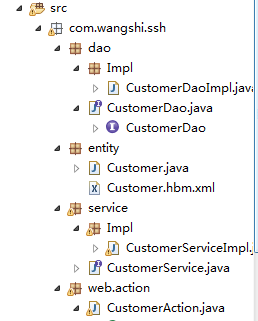SSH框架回顾:

SSH整合:
1.第一步:创建web项目,引入jar包
Struts2的jar包
路径:struts-2.3.24\apps\struts2-blank\WEB-INF\lib\*.jar
Struts2中有一些包需要了解的:
struts2-convention-plugin-2.3.24.jar ----Struts2的注解开发包。
struts2-json-plugin-2.3.24.jar ----Struts2的整合AJAX的开发包。
struts2-spring-plugin-2.3.24.jar ----Struts2的整合Spring的开发包。
Hibernate的jar包:
Hibernate的开发的必须的包
hibernate-release-5.0.7.Final\lib\required\*.jar
MySQL驱动
mysql-connector-java-5.1.7-bin.jar
日志记录

使用C3P0连接池:

注意:Struts2和Hibernate都引入了一个相同的jar包(javassist包),删除一个
Spring的jar包
- IOC的开发

- AOP的开发

- JDBC模板的开发

- 事务管理

- 整合web项目的开发

- 整合单元测试的开发

- 整合hibernate的开发

2.第二步:引入配置文件 - Struts的配置文件
web.xml配置核心过滤器
<!-- 核心过滤器 -->
<filter>
<filter-name>struts2</filter-name>
<filter-class>org.apache.struts2.dispatcher.ng.filter.StrutsPrepareAndExecuteFilter</filter-class>
</filter>
<filter-mapping>
<filter-name>struts2</filter-name>
<url-pattern>/*</url-pattern>
</filter-mapping>
struts.xml
<?xml version="1.0" encoding="UTF-8"?>
<!-- struts2的约束 -->
<!DOCTYPE struts PUBLIC
"-//Apache Software Foundation//DTD Struts Configuration 2.3//EN"
"http://struts.apache.org/dtds/struts-2.3.dtd">
<struts>
<!-- 这是将Struts2和Spring的整合(一) ,记得引包struts-spring-plugin.jar-->
<!-- <constant name="struts.objectFactory" value="spring"/> -->
<!-- 配置Action -->
<package name="ssh1" extends="struts-default" namespace="/">
<!-- <action name="customer_*" class="com.wangshi.ssh.web.action.CustomerAction" method="{1}"> -->
<!-- Spring整合struts2的方式二 ,customerAction是spring配置action的id-->
<action name="customer_*" class="customerAction" method="{1}">
</action>
</package>
</struts>
- Hibernate的配置文件
hibernate.cfg.xml,删除那个与线程绑定的session。
<?xml version="1.0" encoding="UTF-8"?>
<!-- hibernate的约束 -->
<!DOCTYPE hibernate-configuration PUBLIC
"-//Hibernate/Hibernate Configuration DTD 3.0//EN"
"http://www.hibernate.org/dtd/hibernate-configuration-3.0.dtd">
<hibernate-configuration>
<session-factory>
<!-- 连接数据库的基本参数 ==========-->
<property name="hibernate.connection.driver_class">com.mysql.jdbc.Driver</property>
<property name="hibernate.connection.url">jdbc:mysql:///ssh1</property>
<property name="hibernate.connection.username">root</property>
<property name="hibernate.connection.password">root</property>
<!-- 配置Hibernate的方言 -->
<property name="hibernate.dialect">org.hibernate.dialect.MySQLDialect</property>
<!-- 可选配置================ -->
<!-- 打印SQL -->
<property name="hibernate.show_sql">true</property>
<!-- 格式化SQL -->
<property name="hibernate.format_sql">true</property>
<!-- 自动创建表 -->
<property name="hibernate.hbm2ddl.auto">update</property>
<!-- 配置C3P0连接池 -->
<property name="connection.provider_class">org.hibernate.connection.C3P0ConnectionProvider</property>
<!--在连接池中可用的数据库连接的最少数目 -->
<property name="c3p0.min_size">5</property>
<!--在连接池中所有数据库连接的最大数目 -->
<property name="c3p0.max_size">20</property>
<!--设定数据库连接的过期时间,以秒为单位,
如果连接池中的某个数据库连接处于空闲状态的时间超过了timeout时间,就会从连接池中清除 -->
<property name="c3p0.timeout">120</property>
<!--每3000秒检查所有连接池中的空闲连接 以秒为单位-->
<property name="c3p0.idle_test_period">3000</property>
<!-- 引入映射 -->
<mapping resource="com/wangshi/ssh/entity/Customer.hbm.xml"/>
</session-factory>
</hibernate-configuration>
映射文件Customer.hbm.xml
<?xml version="1.0" encoding="UTF-8"?>
<!DOCTYPE hibernate-mapping PUBLIC
"-//Hibernate/Hibernate Mapping DTD 3.0//EN"
"http://www.hibernate.org/dtd/hibernate-mapping-3.0.dtd">
<hibernate-mapping>
<!-- 建立类与表的映射 -->
<class name="com.wangshi.ssh.entity.Customer" table="cst_customer">
<!-- 建立类中的属性与表中的主键对应 -->
<id name="cust_id" column="cust_id" >
<!-- 主键生成策略 -->
<generator class="native"/>
</id>
<!-- 建立类中的普通的属性和表的字段的对应 -->
<property name="cust_name" column="cust_name" />
<property name="cust_source" column="cust_source" />
<property name="cust_industry" column="cust_industry"/>
<property name="cust_level" column="cust_level"/>
<property name="cust_phone" column="cust_phone"/>
<property name="cust_mobile" column="cust_mobile"/>
</class>
</hibernate-mapping>
- Spring的配置文件,spring的核心监听器
web.xml
<!-- spring的核心监听器 -->
<listener>
<listener-class>org.springframework.web.context.ContextLoaderListener</listener-class>
</listener>
<!-- 加载spring的配置文件的路径时,默认加载的/WEB-INF/applicationContext.xml -->
<context-param>
<param-name>contextConfigLocation</param-name>
<param-value>classpath:applicationContext.xml</param-value>
</context-param>
applicationContext.xml
<?xml version="1.0" encoding="UTF-8"?>
<beans xmlns="http://www.springframework.org/schema/beans"
xmlns:xsi="http://www.w3.org/2001/XMLSchema-instance"
xmlns:context="http://www.springframework.org/schema/context"
xmlns:aop="http://www.springframework.org/schema/aop"
xmlns:tx="http://www.springframework.org/schema/tx"
xsi:schemaLocation="http://www.springframework.org/schema/beans
http://www.springframework.org/schema/beans/spring-beans.xsd
http://www.springframework.org/schema/context
http://www.springframework.org/schema/context/spring-context.xsd
http://www.springframework.org/schema/aop
http://www.springframework.org/schema/aop/spring-aop.xsd
http://www.springframework.org/schema/tx
http://www.springframework.org/schema/tx/spring-tx.xsd">
<!-- spring和hibernate的整合 -->
<!-- 引入hibernate的配置的信息========== -->
<bean id="sessionFactory" class="org.springframework.orm.hibernate5.LocalSessionFactoryBean">
<!-- 引入hibernate的配置文件========== -->
<property name="configLocation" value="classpath:hibernate.cfg.xml"/>
</bean>
<!-- Spring整合struts2的方式二,配置action 为多例 -->
<bean id="customerAction" class="com.wangshi.ssh.web.action.CustomerAction" scope="prototype">
<!-- 手动注入service -->
<property name="customerService" ref="customerService"/>
</bean>
<!-- 将Service交给spring管理 -->
<!-- 配置service=========== -->
<bean id="customerService" class="com.wangshi.ssh.service.Impl.CustomerServiceImpl">
<property name="customerDao" ref="customerDao" />
</bean>
<!-- 将dao层交给spring -->
<!-- 配置dao========== -->
<bean id="customerDao" class="com.wangshi.ssh.dao.Impl.CustomerDaoImpl">
<!-- 注册SessionFactory就会创建hibernate的模板 -->
<property name="sessionFactory" ref="sessionFactory"/>
</bean>
<!-- 配置spring的事务管理 -->
<!-- 配置事物管理器 -->
<bean id="transactionManager" class="org.springframework.orm.hibernate5.HibernateTransactionManager">
<property name="sessionFactory" ref="sessionFactory"/>
</bean>
<!-- 开启事务注解 -->
<tx:annotation-driven transaction-manager="transactionManager"/>
</beans>
日志记录:log4j.properties
### direct log messages to stdout ###
log4j.appender.stdout=org.apache.log4j.ConsoleAppender
log4j.appender.stdout.Target=System.err
log4j.appender.stdout.layout=org.apache.log4j.PatternLayout
log4j.appender.stdout.layout.ConversionPattern=%d{ABSOLUTE} %5p %c{1}:%L - %m%n
### direct messages to file mylog.log ###
log4j.appender.file=org.apache.log4j.FileAppender
log4j.appender.file.File=c\:mylog.log
log4j.appender.file.layout=org.apache.log4j.PatternLayout
log4j.appender.file.layout.ConversionPattern=%d{ABSOLUTE} %5p %c{1}:%L - %m%n
### set log levels - for more verbose logging change 'info' to 'debug' ###
# error warn info debug trace
log4j.rootLogger= info, stdout
3.第三步:创建包结构
4.第四步:创建相关类

5.第五步:引入相关的页面
6.第六步:修改add.jsp

第七步:Spring整合Struts2[两种方式]
Spring整合Struts2方式一:Action由Struts2自身创建的
编写Action
package com.wangshi.ssh.web.action;
import org.apache.struts2.ServletActionContext;
import org.springframework.web.context.WebApplicationContext;
import org.springframework.web.context.support.WebApplicationContextUtils;
import com.opensymphony.xwork2.ActionSupport;
import com.opensymphony.xwork2.ModelDriven;
import com.wangshi.ssh.entity.Customer;
import com.wangshi.ssh.service.CustomerService;
/**客户管理的Action的类
* @author wanghaichuan
*/
public class CustomerAction extends ActionSupport implements ModelDriven<Customer> {
//模型驱动使用的对象
private Customer customer = new Customer();
@Override
public Customer getModel() {
return customer;
}
//注入CustomerService;
private CustomerService customerService;
public void setCustomerService(CustomerService customerService) {
this.customerService = customerService;
}
/**
* 保存客户的方法:save
*/
public String save(){
//传统方式[如果web层没有使用struts2,获取业务层的类就必须如下进行编写:]
/*WebApplicationContext applicationContext = WebApplicationContextUtils
.getWebApplicationContext(ServletActionContext.getServletContext());
CustomerService customerService = (CustomerService) applicationContext.getBean("customerService");*/
System.out.println("Action中的save方法执行了.....");
customerService.save(customer);
return NONE;
}
}
配置Action[在struts.xml中配置]
<?xml version="1.0" encoding="UTF-8"?>
<!-- struts2的约束 -->
<!DOCTYPE struts PUBLIC
"-//Apache Software Foundation//DTD Struts Configuration 2.3//EN"
"http://struts.apache.org/dtds/struts-2.3.dtd">
<struts>
<!-- 这是将Struts2和Spring的整合(一) ,记得引包struts-spring-plugin.jar-->
<!-- <constant name="struts.objectFactory" value="spring"/> -->
<!-- 配置Action -->
<package name="ssh1" extends="struts-default" namespace="/">
<!-- <action name="customer_*" class="com.wangshi.ssh.web.action.CustomerAction" method="{1}"> -->
<!-- Spring整合struts2的方式二 ,customerAction是spring配置action的id-->
<action name="customer_*" class="customerAction" method="{1}">
</action>
</package>
</struts>
在Action中引入Service,详情请看上面代码
传统方式

进行Spring和Struts2的整合:
引入struts-spring-plugin.jar
在插件包中有如下配置

*****开启一个常量:在Struts2中只有开启这个常量就会引发下面常量生效:

让Action按照名称自动注入Service
将Service交给Spring管理
<!-- 将Service交给spring管理 -->
<!-- 配置service=========== -->
<bean id="customerService" class="com.wangshi.ssh.service.Impl.CustomerServiceImpl">
<property name="customerDao" ref="customerDao" />
</bean>
在Action注入Service

第八步:Spring整合Struts2方式二
Spring整合Struts2方式二:Action交给Spring管理(推荐)
引入struts-spring-plugin.jar
将Action交给Spring:
<!-- Spring整合struts2的方式二,配置action 为多例 -->
<bean id="customerAction" class="com.wangshi.ssh.web.action.CustomerAction" scope="prototype">
<!-- 手动注入service -->
<property name="customerService" ref="customerService"/>
</bean>
在struts.xml中配置Action:

注意:
需要配置Action为多例的;需要手动注入Service

9.第九步:Service调用DAO
将DAO交给Spring管理

在Service注入DAO
 将Service交给spring管理
将Service交给spring管理
<!-- 配置service=========== -->
<bean id="customerService" class="com.wangshi.ssh.service.Impl.CustomerServiceImpl">
<property name="customerDao" ref="customerDao" />
</bean>
10.第十步:Spring整合Hibernate框架
创建数据库和表
package com.wangshi.ssh.entity;
/**
* 客户管理的实体
* @author wanghaihcaun
*Create database ssh1;
Use ssh1;
CREATE TABLE `cst_customer` (
`cust_id` bigint(32) NOT NULL AUTO_INCREMENT COMMENT '客户编号(主键)',
`cust_name` varchar(32) NOT NULL COMMENT '客户名称(公司名称)',
`cust_source` varchar(32) DEFAULT NULL COMMENT '客户信息来源',
`cust_industry` varchar(32) DEFAULT NULL COMMENT '客户所属行业',
`cust_level` varchar(32) DEFAULT NULL COMMENT '客户级别',
`cust_phone` varchar(64) DEFAULT NULL COMMENT '固定电话',
`cust_mobile` varchar(16) DEFAULT NULL COMMENT '移动电话',
PRIMARY KEY (`cust_id`)
) ENGINE=InnoDB AUTO_INCREMENT=1 DEFAULT CHARSET=utf8;
*/
public class Customer {
private Long cust_id;
private String cust_name;
private String cust_source;
private String cust_industry;
private String cust_level;
private String cust_phone;
private String cust_mobile;
public Long getCust_id() {
return cust_id;
}
public void setCust_id(Long cust_id) {
this.cust_id = cust_id;
}
public String getCust_name() {
return cust_name;
}
public void setCust_name(String cust_name) {
this.cust_name = cust_name;
}
public String getCust_source() {
return cust_source;
}
public void setCust_source(String cust_source) {
this.cust_source = cust_source;
}
public String getCust_industry() {
return cust_industry;
}
public void setCust_industry(String cust_industry) {
this.cust_industry = cust_industry;
}
public String getCust_level() {
return cust_level;
}
public void setCust_level(String cust_level) {
this.cust_level = cust_level;
}
public String getCust_phone() {
return cust_phone;
}
public void setCust_phone(String cust_phone) {
this.cust_phone = cust_phone;
}
public String getCust_mobile() {
return cust_mobile;
}
public void setCust_mobile(String cust_mobile) {
this.cust_mobile = cust_mobile;
}
}
编写实体和映射
Spring和Hibernate整合
在Spring的配置文件中,引入Hibernate的配置的信息

在Spring和Hibernate整合后,Spring提供了一个Hibernate的模板类简化Hibernate开发。
改写DAO继承HibernateDaoSupport

配置的时候在DAO中直接注入SessionFactory

在DAO中使用Hibernate的模板完成保存操作
package com.wangshi.ssh.dao.Impl;
import org.springframework.orm.hibernate5.support.HibernateDaoSupport;
import com.wangshi.ssh.dao.CustomerDao;
import com.wangshi.ssh.entity.Customer;
/**
* @author wanghaichuan
*这是客户管理dao层的实现
*/
public class CustomerDaoImpl extends HibernateDaoSupport implements CustomerDao {
@Override
public void save(Customer customer) {
System.out.println("这是dao层中的save方法.......");
//使用模板完成操作
this.getHibernateTemplate().save(customer);
}
}
11.第十一步:配置Spring的事务管理
配置事务管理器

开启注解事务

在业务层使用注解

---------------------------------------最后启动服务器,看是否成功添加,页面不跳转!





















 182
182











 被折叠的 条评论
为什么被折叠?
被折叠的 条评论
为什么被折叠?








